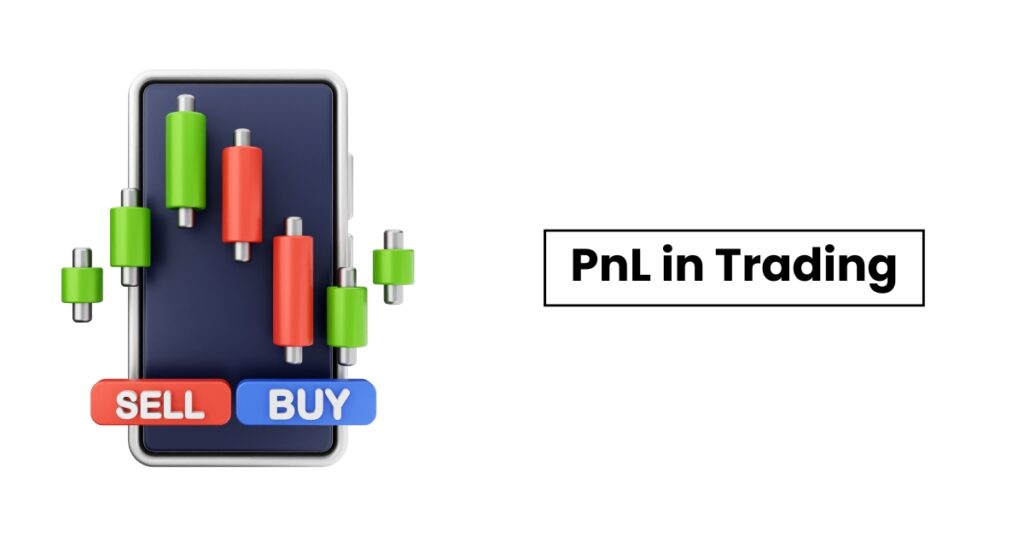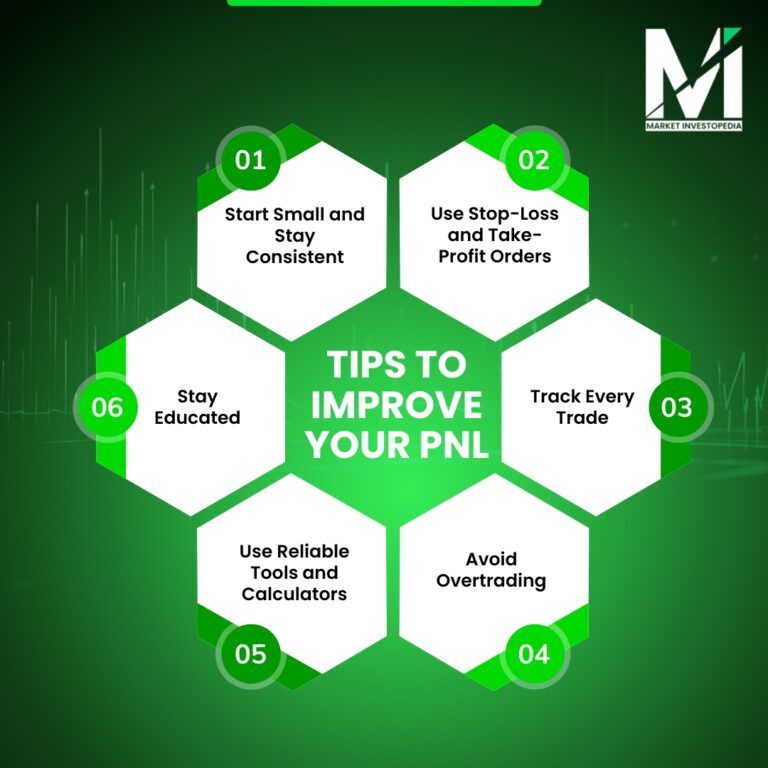What is PNL in Trading and Crypto? Meaning, Calculation & Tips for Beginners
If you have just started exploring the world of trading or crypto, you’ve probably come across the term PNL, short for Profit and Loss. You might be wondering, “PNL meaning?” or “What is PNL?” It’s one of the most important metrics used by traders to measure how well (or poorly) their trades are performing. Understanding what PNL means and how it works can help you track your progress, control risk, and make smarter decisions. Whether you are into stocks, forex, or crypto, knowing your P&L (Profit and Loss) is key to long-term success.
At Market Investopedia, we believe in making trading knowledge simple and accessible. This guide will walk you through everything you need to know about PNL in the easiest way possible.
What is PNL in Trading?
In trading, PNL stands for Profit and Loss; it tells you whether you are making money or losing it on a trade. It’s like a scoreboard that shows the results of your buying and selling decisions. Every time you open or close a trade, your P&L changes based on how the price moves.

There are two types of PNL you’ll often see:
- Realised PNL:This is the real loss & profit you have incurred after closing a trade. For example, when you purchased gold at 1,800 and sold it at 1,850, your realised gain is 50.
- Unrealised PNL: This is also referred to as floating PNL, and it indicates the profit or loss of open trades. It fluctuates with the movement of market prices, but it is not fixed until you close the position.
Traders watch their P&L management to assess their strategy, manage risk, and decide whether to hold or exit a trade. Regardless of whether you are day trading, swing trading, or investing long-term, monitoring your PNL will keep you focused on facts instead of emotions.
Keep in mind: Big profits may seem thrilling, but even minor steady profits are potent. The first step to becoming a disciplined and successful trader is understanding your P&L.
A quick glance
PNL is an abbreviation of Profit and Loss. It indicates the amount of money you have gained or lost due to your trades, and this assists you in monitoring your overall trading performance.
An ideal PNL ratio is typically more than 1, implying that your profits are more than your losses. A 2:1 ratio is the goal of many traders to maintain a low risk and stable gains.
PNL is computed by deducting the buying price and the selling price and multiplying the result by the quantity. Do not forget to deduct any fees or charges.
Realised PNL is the actual profit or loss you get when you close a trade. It indicates the amount of money you have won or lost, and it does not change any more.
What is a PNL in Crypto Trading?
In the fast-moving world of crypto, PNL, or Profit and Loss, plays a crucial role in tracking how much you are earning or losing on your trades. Just like in traditional markets, PNL in crypto shows the financial result of your positions based on market price changes.
Crypto trading isn’t just about buying low and selling high; it’s about knowing exactly where you stand at any given moment. That’s where PNL meaning becomes vital. In crypto, your P & L helps track the real-time outcome of your trades in a market that moves 24/7.
What makes PNL in crypto different from traditional trading is the speed and unpredictability. Prices of tokens like Bitcoin, Ethereum, or altcoins can swing wildly in seconds. So your open positions can show big gains or losses even if you haven’t closed the trade yet.
Here’s what makes crypto PNL unique:
High leverage and margin trading often amplify both profit to loss, making P&L management even more critical.
Many traders operate across different pairs, BTC/USDT, ETH/BTC, or even meme coins, so tracking unrealized PNL across assets becomes essential.
Exchanges often show net P&L, which includes funding fees, trading fees, and bonuses.
Your crypto P&L is your trading health monitor; it indicates whether your strategy is working or needs adjustment. Most platforms like Binance, Kraken, or Bybit display this data in real-time.
How to Calculate PnL
Learning how to compute your P&L profit helps you understand your financial standing in trading, whether it’s stocks, forex pairs, or digital assets.
Basic Formula for Profit and Loss
The standard way to calculate your PNL manually is:
PNL = (SP -BP) x Q – Fees
This gives you the amount of loss & profit from a completed transaction after trading costs.
Realised PNL Example
Suppose you bought 2 BTC at $25,000 and sold them at $27,000.
PNL = (27,000 – 25,000) × 2 = 4,000 Fees = 100
Final PNL = 4,000 – 100 = 3,900
This is your realised profit, i.e., actual gai
Unrealised PNL Example
Imagine that you still have Ethereum purchased at 2,000, and it is now worth 1,800.
Unrealized PNL = (2,000 – 1,800) x Quantity
This is a possible loss, yet not final until the asset is sold.
Tools That Help
Most trading platforms automatically calculate both forms of PNL, but knowing the math allows you to cross-check and manage better.
Whether in forex, stocks, or digital markets, P&L management helps you monitor your profit to loss over time.
Why PNL Matters: Benefits, Uses & Mistakes to Avoid
PNL (Profit and Loss) is not only about looking at the numbers, whether you are a novice or a professional trader, but it is about assessing the effectiveness of your strategy.
Benefits of Tracking PNL
- Performance Check: Your PNL indicates how accurate you are in trading. A consistent positive PNL indicates good decision-making; a negative one indicates a change of strategy.
- Risk Management: Risk can be controlled by monitoring your profit to loss ratio. When you have more losses than gains, it is an indication that you need to reconsider the size of your trade or the entry points.
- Capital Planning: Understanding your P&L will assist you in determining the amount of capital to use, the duration to remain in trades, and the time to exit.
Common Mistakes Beginners Make
- Forgetting Unrealised losses: Unrealised losses in open trades are not harmless. Should the market move further, then those unrealised losses may turn into large realised losses.
- Ignoring Fees: Most people do not consider trading fees, spreads or funding expenses. These decrease your real PNL more than you imagine.
- Profit-Only: Emotional trading is caused by chasing green numbers. It is sometimes wiser to cut small losses early rather than to hold and hope.
Tip: Do not make your PNL a game score. Make it a learning tool. Look at your trades once a week or once a month to see patterns, good or bad.
In a nutshell, monitoring your PNL regularly instils trading discipline and enhances decision-making. It is not a matter of profit or loss, but growth.
Tips to Improve Your PNL
It is not about being lucky to improve your PNL, it is about building habits that will preserve your capital and increase your trading abilities. These are some simple, novice-level tips to make your loss and profit ratio work in your favour.

Start Small and Stay Consistent
Start with a small capital. Learn to follow the market instead of pursuing short-term gains. Small improvements can create confidence in the long run.
Use Stop-Loss and Take-Profit Orders
These tools assist you in managing risk and preventing emotional decisions. A stop-loss prevents you from losing more than you want, and a take-profit secures profits before the market turns.
Track Every Trade
Maintain a basic trading journal and note your entry, exit, reason to trade, and outcome. This will enable you to know what strategies are making your P&L profit, better and which ones are not.
Avoid Overtrading
The more trades, the more profit does not imply. There are times when it is wiser to sit out than to get into a risky setup. Winning is protecting your capital.
Use Reliable Tools and Calculators
PNL calculators and analysis dashboards are offered by many platforms. Check your profit to loss (loss & profit) ratio using them before making a trade.
Stay Educated
Markets change. Continue to study technical analysis, market news and risk management. The more you learn, the better you perform.
Wrapping Up
Understanding PNL meaning and how it works is a core part of becoming a smarter trader. Whether you’re into crypto, forex, or stocks, tracking your P & L allows for better discipline, risk control, and strategy improvement.
When you learn how to calculate your P&L, recognize patterns, and adopt better trading habits, you’ll not only protect your capital but grow it.
At Market Investopedia, we aim to make trading education simple and actionable. If you need help optimizing your P&L strategy, feel free to reach out. we’re here to support your growth.

